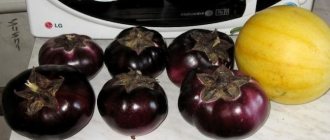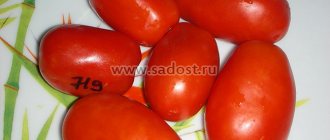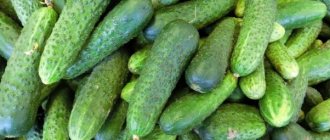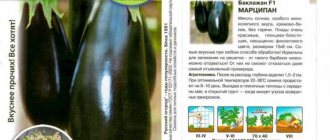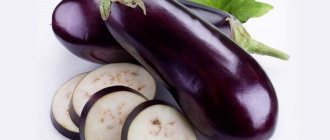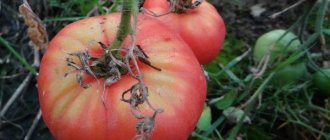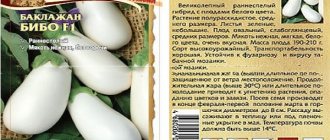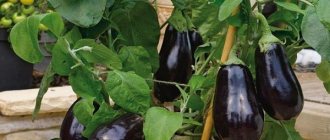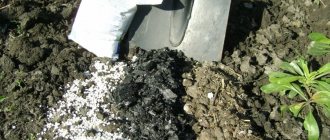Description
Eggplant Galina F1 can be grown in the garden or in a greenhouse. It also depends on the region. In the south, you can get a good harvest in the garden, but the seedlings are grown in a greenhouse or indoors. In regions of risky farming, greenhouses are used. Eggplant Galina F1 is an early variety. You can get the first fruits already on the 95th day. And on the 105th day, Galina’s eggplant produces a full harvest. Description of the variety and photos indicate that the bush is semi-spreading, strong, and branched. The stem is anthocyanin purple in color. In a greenhouse it grows up to 90 cm, in the garden - up to 70 cm. The leaves are medium in size. The calyx is practically spineless.
The fruits are cylindrical, with a pear-shaped ending, dark purple, “eggplant” in color with a black tint. The weight of one fruit reaches 300-600 g. The length of each fruit is up to 18 cm with a diameter of up to 8 cm. On one bush they can grow up to 15 pieces. The flesh of the eggplant variety Galina is white, without bitterness. There are few seeds and they are small. Therefore, they practically do not interfere with the preparation of eggplant dishes.
Eggplant Galina F1 (photo) is valued because it can be grown in different climatic conditions, it is unpretentious, and does not require special care. Can be stored for a long time in a cool place. The variety is resistant to disease and cold.
The best varieties and hybrids for open ground
Varieties and hybrids for open ground are immune to insect pests and diseases. Productivity does not depend on rain, winds and other climatic features.
Alekseevsky
The advantage of the variety is its resistance to frost and cold. The branched bushes grow up to 75 cm. The fruit ripening period is 120 days. Eggplant weight is 150 g, cylindrical in shape, tender flesh. Productivity - 9 kg per 1 sq. m. The variety is universal in application.
Vakula
Suitable for growing in gardens and fields. The plant is 1.5 m high, the fruit ripening period is 95-105 days. The pulp is dense, sweetish. The peel is thick, dark purple in color. The weight of one fruit is 400 g, per 1 sq. m harvest up to 12 kg. The Vakula variety is stored for up to three weeks in basements and cellars.
Joker
Up to 10 fruits are formed on one plant, so the bushes need a garter. Plant height is 1.4 m, ripening period is 90 days. The shape of the fruit is rounded and elongated, the color is lilac. Length - 19 cm, diameter - 7 cm. The pulp is light, without a bitter taste. Productivity - 8 kg per 1 sq. m.
Bourgeois f1
Ripening period - 110 days. The hybrid is characterized by a stable harvest and friendly fruiting. The height of the plant is 1.5 m. The round fruits are of a rich purple color, the weight of the fruit is up to 1 kg, the diameter is 14 cm. The hybrid is resistant to late blight and powdery mildew. To obtain a rich harvest, gardeners regularly fertilize the beds with liquid manure.
Negus
Resistant to weather changes. Plant height is 50-60 cm, suitable for planting in small areas. The shape of the fruit is round, the skin is purple, glossy. Weight varies from 200 to 300 g. The pulp is tender and not bitter. Productivity - 5 kg per 1 sq. m. The Negus variety is valued for its taste; eggplant produces delicious caviar.
Chinese lantern
Original red eggplants decorate the garden. The height of the bush is 70 cm, the flowers are large and white. Ripening period - 115 days. The shape of the fruit is round, the color is red or bright orange. The pulp is yellow-white, tasty and pleasant. Weight - 170 g, yield - 3 kg per plant. The harvest looks impressive as a festive table decoration.
Emerald f1
In cultivation, the hybrid is unpretentious and frost-resistant, resistant to diseases. Plant height is 1 m, spreading shoots. Ripening period is 110 days from the appearance of the first shoots. The fruits are elongated, green in color. Vegetable weight - up to 450 g. The pulp is not bitter, beige in color. Productivity - 5 kg per 1 sq. m.
Dragon
The variety is popular in the Urals and Siberia; it can grow in weak soils. Plant height is 1 m, foliage is average. The ripening period varies from 105 to 125 days. The fruits are pear-shaped, the skin is smooth and glossy, purple. Eggplant weight - 300 g, length - 20 cm. Productivity - 5 kg per 1 sq. m.
Productivity of the variety
Hybrid Galina F1 is valued for its high yield. On an area of 1 m2, eggplant grows up to 6-6.5 kg. Fruits set even in unsuitable weather conditions, with temperature fluctuations. This is a very valuable feature that distinguishes the Galina eggplant.
Description of the variety, photos, reviews indicate that from 5 to 8 full-fledged fruits were simultaneously set and ripened on one bush. Their weight can reach half a kilogram. Getting a good harvest is facilitated by the fact that eggplants do not suffer from late blight.
Description of the series of Prince eggplant varieties
From the descriptions and photos of the Prince eggplant varieties, it is clear that in appearance they bear little resemblance. The fruits differ in shape and color, ripening time and their taste characteristics vary. Among the general characteristics it is worth noting: high yield, large-fruited, unpretentious care, the ability to grow throughout Russia, both in open ground in the southern and central regions, and in greenhouses or under film covers in regions with a more severe climate.
Attention!
All varieties described are characterized by a high level of cold resistance. They do not respond to prolonged cold spells by slowing development, dropping flower stalks, or forming barren flowers.
However, they are not frost-resistant. During recurrent frosts, plants grown in open ground need additional shelter.
The drought resistance of all Prince eggplants, the characteristics and descriptions of the varieties of which are given in the article, is average. However, this is a feature of all large-fruited species of this vegetable crop. At the same time, waterlogging can cause diseases such as black leg and gray rot.
Prince eggplant variety
In the photo, Prince eggplants are a compact, densely leafy plant. It rarely reaches a height of more than 70 cm. The stems are powerful, dark green, and acquire purple hues as they grow. The leaves are large, with short stalks. The shape of the leaf plates is oval. They are distinguished by their rich green color and light edge.
The fruits are large, beautiful pear-shaped. They reach a length of 18-20 cm, with a cross-sectional diameter at the widest point of 8-10 cm. The average weight of the Prince eggplant is about 200-230 grams. The skin is smooth, dark blue, almost black in color with a beautiful glossy sheen.
The pulp is light green in color, with a small number of seeds. Very dense and elastic. The taste of this variety is classic, as is its appearance. It is a combination of pungency and slight bitterness.
Eggplant Northern Prince
A young, original variety that receives excellent reviews for its cold resistance. Many vegetable growers consider it ideal for growing in the conditions of Siberia, the Urals and the northwestern regions due to the early onset of fruiting. Eggplants have time to fully ripen in the short summer.
Eggplant Northern Prince forms medium spreading bushes. Thanks to the powerful stems of light green color, plants 50-60 cm high do not need supports or tying. The leaf blades are medium in size, obovate in shape and green in color, appearing grayish due to pubescence.
The fruits have an unusual shape. They are cylindrical, elongated, with a noticeable difference in diameter at the stalk and in the middle part, with a spout. Eggplants are somewhat curved. Their length is 25-30 cm, cut diameter is from 5 to 7 cm. The weight of one eggplant reaches 250-300 grams. The skin color ranges from light purple to bright purple. As it ripens, it darkens a little and acquires a slight gloss.
The flesh of the Northern Prince eggplant is dense and has a pleasant creamy color. Few seeds are produced. The taste of the fruit is bright, with a slight pungency, but without bitterness.
Eggplant variety Eastern Prince
A tall variety of eggplant, reaching a height of 1.5 m. At the same time, the formation of shoots is average, the bushes are not large in volume. This is also evidenced by the fact that they can be planted 50-60 cm apart. The stems and shoots are powerful, but during the period of active fruiting they need support.
Eastern Prince eggplant is a variety with a fruit color unusual for this crop. Eggplants are uniform in size, regular cylindrical in shape, with mild ribbing. The length of the fruit is 25-27 cm, weight is about 250 grams. The color of the delicate skin is bright yellow, without gloss.
According to gardeners, the Eastern Prince eggplant has an excellent delicate taste, without any signs of bitterness. Its flesh is greenish in color, dense, and the number of seeds is small.
Eggplant variety Prince Fairytale
And another Prince, this time the Fairytale One. Plants of this variety are low-growing, compact, with small oval-shaped leaves and bright green color. Produces a large number of fruits elongated to 25-28 cm. Their weight is in the range of 210-250 grams. Eggplants of the Prince Fairytale variety, according to reviews and photos, have a cylindrical shape and are slightly curved in the middle part. Their color is dark purple with a noble glossy sheen.
The variety is praised for its snow-white dense pulp, almost complete absence of seeds and original taste with a medium degree of pungency.
Growing seedlings
Like all eggplants, the Galina F1 variety is grown from seedlings. It is taken into account that it is demanding of heat and light and loves moisture. Seeds are sown early, in mid-February. Before sowing, they are disinfected with a solution of Fitosporin or other antifungal drugs. One and a half grams of the drug are diluted in a liter of water and the seeds are placed for 2 hours. Users advise using the same brand of paste. Then the seeds are soaked for 18 hours in the Epin solution. For 100 ml of water you will need 4 drops of the drug.
The seeds are sent for germination. This can be done using peat tablets if the number of seeds is small. You can use hydrogel. The advantage of using it is that the roots are not damaged during such germination. The seeds themselves receive optimal conditions for germination; they do not dry out or become waterlogged. Seeds germinate at a temperature of about 27 degrees. After the seeds have sprouted, they are planted in prepared bags with soil mixture. One seed treated with Zircon solution is placed in each and sprinkled with soil up to 2 cm thick. In order for the sprouts to shed their seed shells, the soil in the bag is compacted from above.
The temperature in the room where eggplants are grown should be about 24 degrees. Shoots appear on the 10th day. The temperature is reduced for a week to 16 degrees, then raised again to 24. At night the room should be cooler so that the plants do not stretch upward. It is advisable to extend the daylight hours for seedlings to 14 hours. For this purpose, special phytolamps or fluorescent lamps are used. It is necessary to water moderately so that the seedlings do not disappear from fungal diseases; “black leg” is considered one of the most dangerous.
When the seedlings have formed a second true leaf, they are picked. This contributes to the formation of strong seedlings. It is planted in the greenhouse in mid-May. The time of planting in open ground depends on the growing region. By this time, the threat of return frosts should have passed.
Feed the seedlings with the Uniflor-rost solution. Add 1 teaspoon of product to 5 liters of water. When the seedling has formed its third true leaf, it is treated with Extrasol solution, in the 7-leaf phase with Epin.
Eggplants in purple outfit
Traditionally, in Russian gardens, purple-colored eggplants lead in popularity, and the palm almost throughout the country belongs to two varieties of eggplant.
This is the Black Beauty variety, which attracts the attention of gardeners not only for its unpretentiousness and the ability to grow both in film greenhouses and in open ground, but also for its decent yield and quality of fruit. Dense brown-purple eggplants weighing 200–350 grams do not have a bitter aftertaste, store well and are not susceptible to common diseases of this crop.
Second in the garden popularity ranking is the Almaz eggplant variety, distinguished by its 200-gram fruits of deep purple color. The shape of the fruit is oblong, smooth, the pulp has a pleasant taste without any signs of bitterness.
In addition to these well-known varieties, other varieties are worthy of gardeners’ attention:
- producing a lot of small, oblong fruits, weighing up to 150 grams, the Purple Miracle variety;
- eggplant variety Banana with elongated fruits that can be stored for a long time without loss of quality;
- large-fruited Black Beauty variety with fruits up to 900 grams, bright black and purple color.
Adherents of the traditional pear-shaped form will like the productive Albatross variety, which forms compact bushes from which large, up to 450 grams in weight, blue-violet fruits with dense greenish flesh are harvested.
Round eggplants, which are gaining popularity, are convenient for stuffing, canning and stewing, so varieties and hybrids that produce fruits of this shape are becoming increasingly in demand.
An example of a plant of this type is the Black Moon variety of domestic selection, which produces almost ribbed spherical fruits of a dark purple color with a glossy surface and light green flesh without traces of bitterness. Eggplants weighing from 200 to 350 grams can be harvested within 110–115 days after planting, and the ovary is formed even at low temperatures, and the plant stably bears fruit for a long time. The high-yielding early hybrid Bourgeois also produces round eggplants with a glossy black-purple surface and almost white tender flesh. The weight of the fruit reaches 400–600 grams.
For cultivation in film and winter greenhouses, you can choose the City F1 eggplant of medium ripening, characterized by high stable yield, excellent taste and transportability of the fruit. The plant is powerful, reaching a height of more than 1.8 meters, and bears large cylindrical fruits weighing up to 0.5 kg.
The eggplant variety Dirigible is in no way inferior in yield, whose fruits weighing up to 120 grams can be harvested 125–135 days after emergence. Due to the dense crown and abundance of foliage, the yield may fall, so plants of this type of eggplant require thinning and removal of excess shoots and leaves.
Planting seedlings
You should not plant Galina eggplants after tobacco and nightshades (potatoes, tomatoes). Gardeners advise growing them in such a plot only after 4 years. Eggplants do not like acidic and dense soils.
How to plant Galina F1 eggplants correctly? Reviews from gardeners indicate that before planting seedlings, the plants are watered so that the entire soil lump is moistened. Then they cut the bag on the side in order to disturb the root system of the plant as little as possible. Straighten the bottom, where many roots are located. Place it in a pre-prepared hole. A teaspoon of superphosphate is also added there. Watered. Mulch the soil under the eggplants.
If eggplants are replanted without a clod of soil, their root system may be disrupted. Plants will be stunted. To improve their condition, you can feed them with Kornevin.
Some users recommend adding several hydrogel crystals, for example, Teraveta, to the holes for planting eggplant Galina F1.
Growing eggplant in open ground
Eggplant is more heat-loving than pepper. The growing place should be well lit and warmed by the sun, protected from cold winds.
If there is no natural wind protection, you need to make wing strips. Reliable protection from winds of various directions are strip sowing of peas and beans. Between the scenes a favorable microclimate is created for growing plants.
The best predecessors of eggplant: peas, beans, beans, cucumber, cabbage, table root vegetables.
Eggplants can be grown on heavy soils by making ridges and adding 1 bucket of peat and humus per 1 m2. It is also very useful to add coarse river sand, straw cuttings or sawdust. All this will make the soil lighter.
High doses of organic fertilizers (2–6 kg/m) in the form of compost or humus are the main condition for successful cultivation of eggplant in open ground.
Eggplant is responsive to phosphorus-potassium nutrition throughout the entire growing period. Therefore, when cultivating the soil, it is necessary to add 300–500 grams of ash or 50–100 grams of superphosphate and potassium salt per 1 m2.
Soil for eggplants
The soil for eggplant must be prepared in the fall. You need to dig with a shovel full, carefully removing the roots and rhizomes of perennial weeds. Fresh manure is applied in the fall, and rotted manure in the spring. Peat, straw cuttings and sawdust are also best applied during autumn tillage.
In early spring, as soon as the soil dries slightly, it is loosened with a rake. Spring tillage begins when the soil warms up well. When digging, weed residues are removed, pest larvae and caterpillars are manually selected, and organic and mineral fertilizers are applied. Then the soil is leveled with a rake.
Since spring digging of the soil is carried out at the end of April or beginning of May, the area is loosened several times before planting the seedlings. Loosening is best done after rain to retain moisture in the soil. In addition, loosening is also necessary as a means of weed control.
Seedlings are planted in open ground when the danger of frost has passed: late May - early June. The technique for planting eggplant seedlings is the same as for peppers, the distance between plants is 30–40 cm, between rows - 60 cm.
Caring for eggplants in open ground
Caring for eggplants involves regularly loosening the rows, watering, fertilizing, and controlling weeds, pests and diseases.
After rain or watering, loosen the soil as soon as it dries slightly and forms a light crust. When loosening, weeds are also destroyed.
The soil should be sufficiently moist. It is necessary to water systematically, not allowing it to dry out. Water for irrigation must be heated in the sun so that the water temperature is not lower than +20 °C.
The first feeding of eggplants is carried out 10–15 days after planting the seedlings with slurry, bird droppings or a solution of mineral fertilizers. For 10 liters of water take 40–50 grams of superphosphate, 10 grams of ammonium nitrate or 30 grams of urea, 15–20 grams of potassium salt. When feeding with bird droppings, add 200 grams of ash per 10 liters of solution.
The second feeding is necessary 20 days after the first, and the doses of phosphorus and potassium fertilizers are increased by 1.5–2 times.
The third feeding is at the beginning of fruiting. For 10 liters of water take 60–80 grams of urea, superphosphate and 20 grams of potassium chloride. 10 liters of solution are consumed per 5 m2 of planting. After each feeding, plants should be watered with clean water to avoid burns from fertilizers.
Eggplant care
Galina F1 eggplant requires special care and attention. Features of cultivation:
- Water eggplants only with warm water. When watering cold, the plant gets stressed and may get sick.
- Gardeners often complain that the lower leaves of eggplants turn yellow. This can happen after the plant is transplanted into a greenhouse or open ground.
- The leaves are turning yellow.
If you properly care for the plants, after a while their condition will return to normal. If only the edges of all the leaves turn yellow, and they themselves curl upward, this means that the plant lacks potassium. Fertilizers need to be applied.
If eggplant leaves curl, this can be caused by several reasons:
- Low light.
- Excess moisture.
- Pest damage.
While the first two reasons are easy to eliminate, pests sometimes go unnoticed for a long time.
Diseases and pests
The main diseases that can affect Galina F1 eggplant are gray rot, tobacco mosaic, and black leg. The most dangerous is tobacco mosaic. This is a viral disease. The leaves lighten, then become covered with mosaic spots. Leaves often change shape. For prevention, treat the seeds with a solution of hydrochloric acid for half an hour, then wash them with running water. Consumer reviews advise spraying plants with skim milk and laundry soap every 10 days.
What pests damage Galina F1 eggplants the most? Reviews from gardeners say that it is the Colorado potato beetle, spider mites, aphids, and slugs. The Colorado potato beetle and its larvae can destroy an eggplant plantation in a couple of days. Experts say that without special processing it will not be possible to obtain a high yield. Before planting, soak the roots of the plant in Aktara solution (a bag of 2 liters of water) for 2 hours. This treatment will allow you not to use chemical protection until the fall. If treatment is necessary, you can use Actofit. His waiting period is minimal, only 2 days.
Eggplants in the greenhouse are affected by spider mites. They can be found on the underside of the leaf. They feed on the sap of the plant, so it may die if they are not dealt with in time. Sometimes spider mites are found in a greenhouse.
Aphids mainly attack young parts of the plant. To avoid infection, you need to ventilate the greenhouse well. Treat with insecticide before flowering.
Greenhouse whitefly larvae, which feed on plant sap, are collected from the underside of the leaf. If you wash them off with water, they will die.
Slugs harm eggplants. They damage fruits and plant parts. The areas between plants are treated with slaked lime.
Mole crickets that live in the ground and feed on plant roots. They can damage the stem of the eggplant, which leads to its death.
